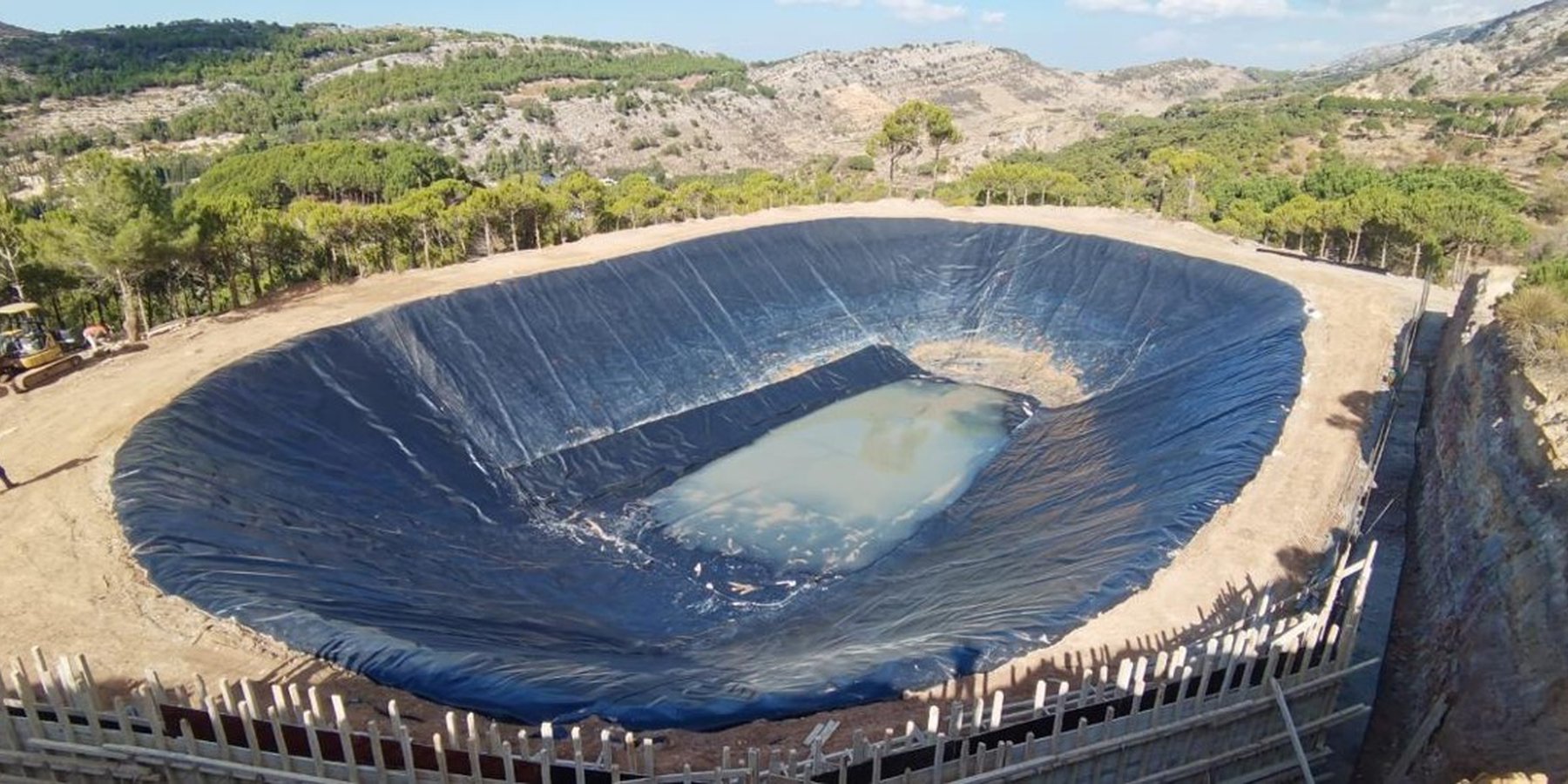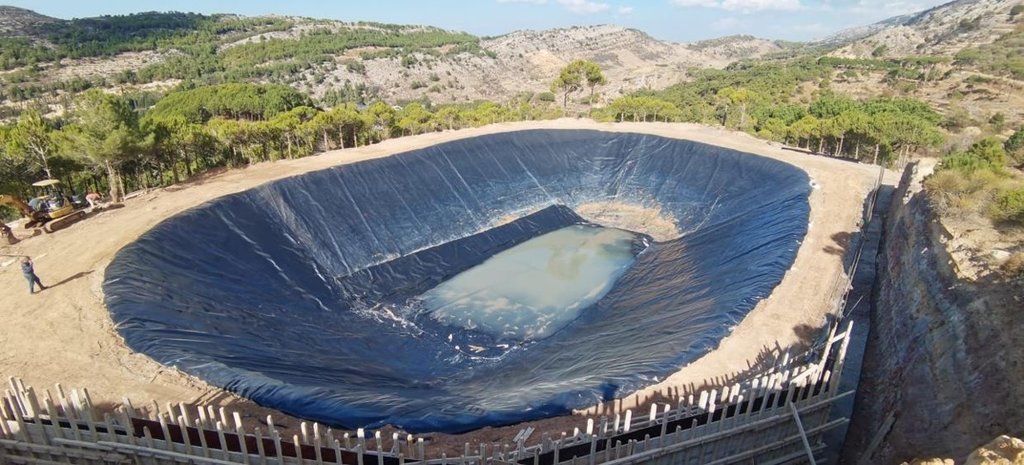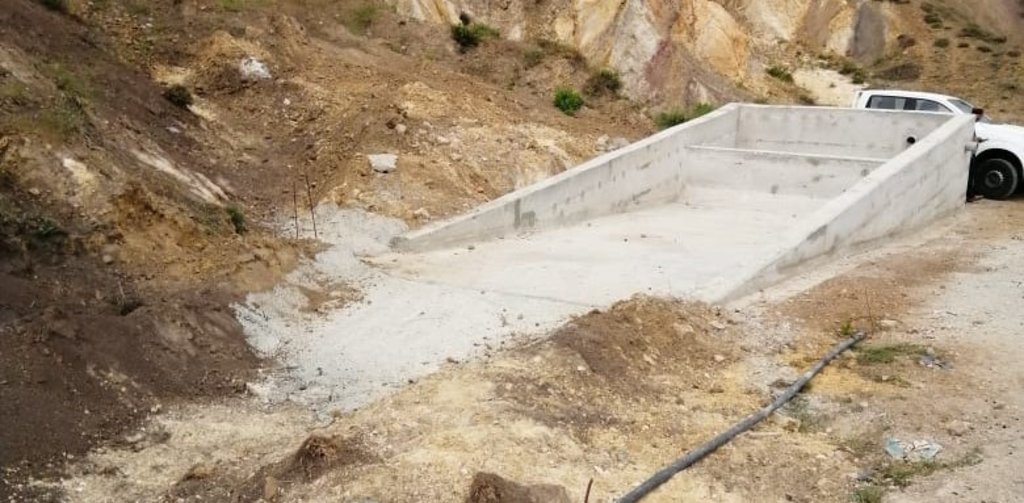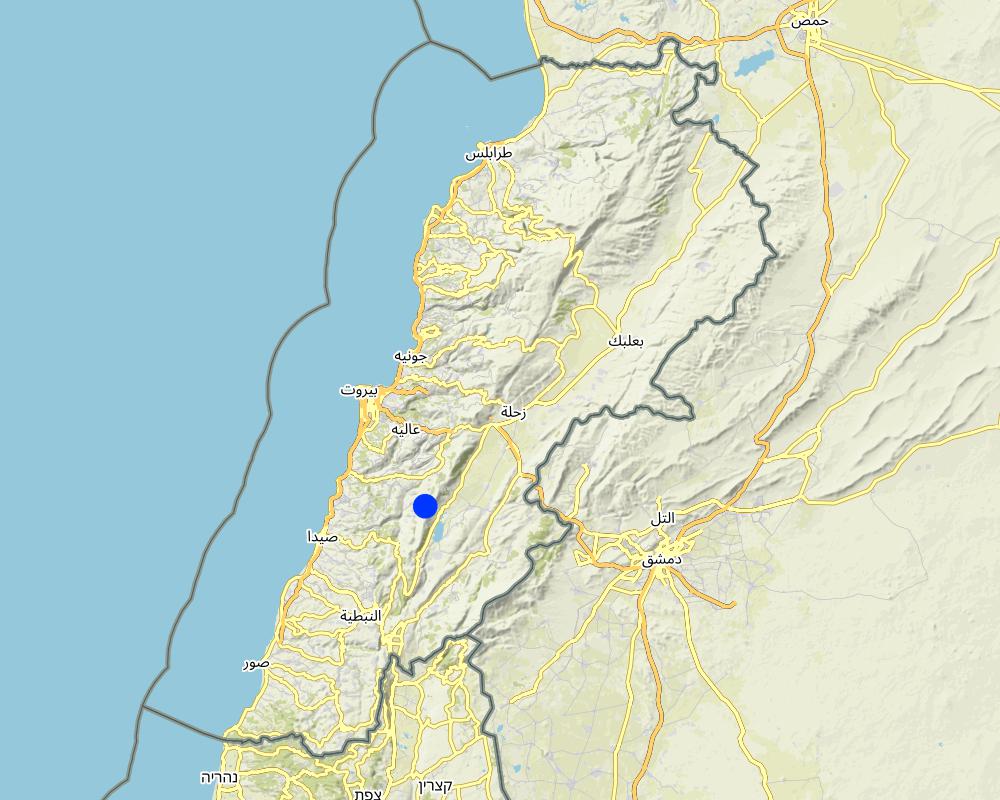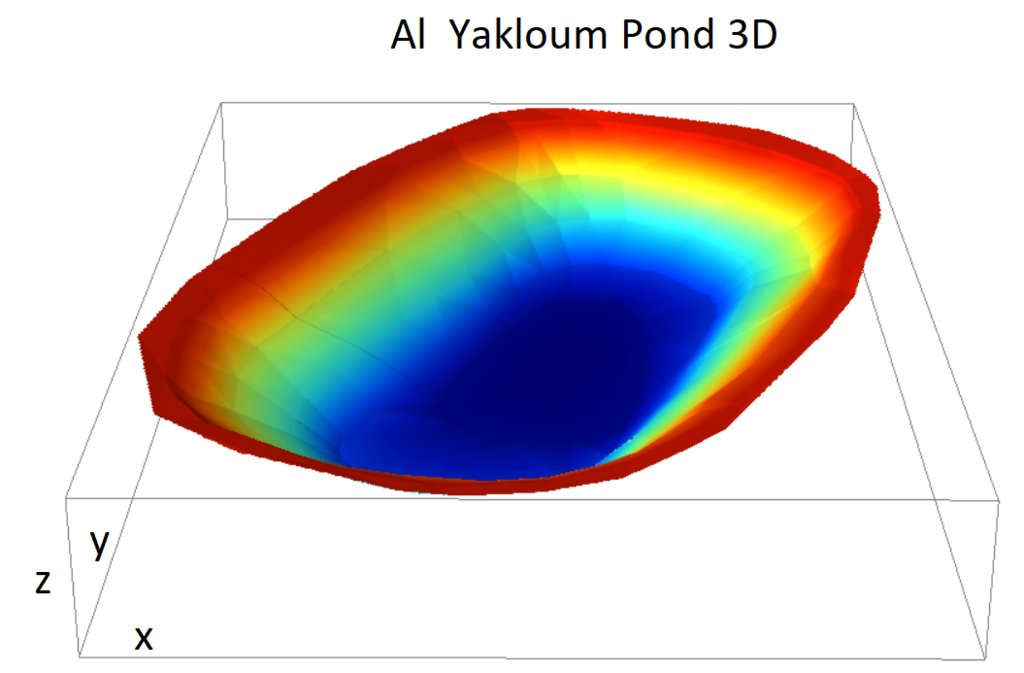Runoff Pond Al Yakloum [黎巴嫩]
- 创建:
- 更新:
- 编制者: Nicola D'Alberton
- 编辑者: –
- 审查者: William Critchley, Rima Mekdaschi Studer
Birki Al Yakloum
technologies_6319 - 黎巴嫩
查看章节
全部展开 全部收起1. 一般信息
1.2 参与该技术评估和文件编制的资源人员和机构的联系方式
1.3 关于使用通过WOCAT记录的数据的条件
编制者和关键资源人员接受有关使用通过WOCAT记录数据的条件。:
是
1.4 所述技术的可持续性声明
这里所描述的技术在土地退化方面是否存在问题,导致无法被认为是一种可持续的土地管理技术?:
否
2. SLM技术的说明
2.1 技术简介
技术定义:
The Al Yakloum pond collects runoff from a local catchment and water is led through a channel system alongside a farm road. Sandy particles are captured in a sediment trap before runoff enters the pond. The pond provides water to approximately 5 ha of orchard - which is irrigated through a precision system.
2.2 技术的详细说明
说明:
The Al Yakloum Pond is located in a public area within the municipality of Mrusti (Mount Lebanon). Runoff water is collected from a natural catchment and is led to the pond through a channel that runs alongside a farm road. The catchment area is mostly unproductive private land, and extends to approximately 2 ha in total. Sediment is an issue in the catchment due to the fine sandy outcrops. Sandy particles are thus carried in the runoff – and require settling out in a sediment trap to limit the turbidity of water in the pond. Thus runoff first enters a stilling basin (a sediment trap) where the suspended solids are deposited: runoff is then transferred through a pipe leading to the pond.
The pond's volume is around 7500 m3, and it is used to irrigate an orchard of about 5 ha in size, which is planted to apples, cherries and olives. A precision smart irrigation system is used for water application. The system includes IoT sensors that provide real time information about soil humidity and weather conditions that allow to automatize the valve opening depending on the plant needs thus optimizing the water consumptions. The volume of water collected is not enough to fulfil all the theoretical water requirements of the orchard crops, therefore the irrigation is merely supplementary to rainfall, and its impact on production is limited. However, the alternative water resource in the area is groundwater. This is high cost and has negative environmental impacts. Therefore the runoff pond technology is preferable for the sustainability of agriculture in the area. If the efficiency of runoff water collection and its application can be improved, then pump withdrawal requirements from groundwater sources decrease and this will optimize the efficiency of irrigation.
2.3 技术照片
2.5 已应用该技术的、本评估所涵盖的国家/地区/地点
国家:
黎巴嫩
区域/州/省:
Mount Lebanon
有关地点的进一步说明:
Municipality of Mrusti
具体说明该技术的分布:
- 适用于特定场所/集中在较小区域
技术现场是否位于永久保护区?:
是
如果是,请具体说明:
Shouf Biosphere Reserve (SBR) - Buffer Zone
Map
×2.6 实施日期
注明实施年份:
2002
如果不知道确切的年份,请说明大概的日期:
- 10-50年前
2.7 技术介绍
详细说明该技术是如何引入的:
- 通过项目/外部干预
注释(项目类型等):
Traditionally the land users used to collect water from springs trough small basins. Following the increase of water demand in the area, in 2002 the pond was built trough an external project. In 2022 the pond was restored and connected to the precision smart irrigation system promoted by the project "Saving Water Growing Crops" implemented by "Istituto OIKOS" in partnership with "Al Shouf Cedar Society", " University of Trento" and "Association for Conservation and Environment" and funded by the European Union.
3. SLM技术的分类
3.1 该技术的主要目的
- 改良生产
- 结合其他技术保护流域/下游区域
- 适应气候变化/极端天气及其影响
- 创造有益的经济影响
- 创造有益的社会影响
3.2 应用该技术的当前土地利用类型
同一土地单元内混合使用的土地::
否

农田
- 一年一作
- orchards (apples, cherries, olives ...) vegetables (tomatoes, onions, cucumber...)
每年的生长季节数:
- 1
采用间作制度了吗?:
是
如果是,说明哪些作物是间作的:
Mixed production of vegetables and orchards
采用轮作制度了吗?:
否

水道、水体、湿地
- 池塘、大坝

不毛之地
具体说明:
Unproductive area used as catchment area of approximately 2ha
3.3 由于技术的实施,土地使用是否发生了变化?
由于技术的实施,土地使用是否发生了变化?:
- 否(继续问题3.4)
3.4 供水
该技术所应用土地的供水:
- 混合雨水灌溉
3.5 该技术所属的SLM组
- 集水
- 灌溉管理(包括供水、排水)
- 引水和排水
3.6 包含该技术的可持续土地管理措施

结构措施
- S5:大坝、集水斗、水池
3.7 该技术强调的主要土地退化类型

土壤水蚀
- Wt:表土流失/地表侵蚀

水质恶化
- Hs:地表水良变化
- Hg:地下水/含水层水位的变化
3.8 防止、减少或恢复土地退化
具体数量名该技术与土地退化有关的目标:
- 修复/恢复严重退化的土地
4. 技术规范、实施活动、投入和成本
4.1 该技术的技术图纸
4.3 技术建立活动
| 活动 | 时间(季度) | |
|---|---|---|
| 1. | Pond Cleaning from sediment | After the irrigation season for the duration of 2 weeks |
| 2. | Geomembrane (HDPE) replacement in damaged spots and compaction of the underneath soil with clay application | Approximately one month |
| 3. | Construction of Retaining Wall to prevent soil erosion on the escarpment close to the pond | Approximately one month |
| 4. | Sedimentation Trap | Approximately two weeks |
| 5. | Rip-rap Channel to convey the water into the Sedimentation Trap | Approximately two weeks |
注释:
The original cost of the implementation of the structure are unknown. The aforementioned activities refer to the rehabilitation of the pond held among the project "Saving Water Growing Crops" in 2022.
4.4 技术建立所需要的费用和投入
| 对投入进行具体说明 | 单位 | 数量 | 单位成本 | 每项投入的总成本 | 土地使用者承担的成本% | |
|---|---|---|---|---|---|---|
| 劳动力 | Cleaning of the ponds from sediment and removal of existing backfill | n | 1.0 | 3000.0 | 3000.0 | |
| 劳动力 | Excavations and Backfilling | n | 1.0 | 3600.0 | 3600.0 | |
| 劳动力 | Maintenance of existing HDPE geomembrane | n | 1.0 | 3000.0 | 3000.0 | |
| 设备 | Geomembrane | m^2 | 1727.0 | 8.0 | 13816.0 | |
| 设备 | Sedimentation Trap | n | 1.0 | 7087.0 | 7087.0 | |
| 设备 | Retaining Wall | n | 1.0 | 21.186 | 21.19 | |
| 设备 | Rip-rap channel | m | 60.0 | 6.0 | 360.0 | |
| 设备 | Fence and Gates along the pond including cast-in-place concrete | m | 160.0 | 38.8 | 6208.0 | |
| 技术建立所需总成本 | 37092.19 | |||||
| 技术建立总成本,美元 | 37092.19 | |||||
如果土地使用者负担的费用少于100%,请注明由谁负担其余费用:
Project "Saving Water Growing Crops" the full costs of rehabilitation
注释:
The original cost of the implementation of the structure are unknown. The aforementioned activities refer to the rehabilitation of the pond implemented among the project "Saving Water Growing Crops" in 2022.
4.6 维护/经常性活动所需要的费用和投入(每年)
| 对投入进行具体说明 | 单位 | 数量 | 单位成本 | 每项投入的总成本 | 土地使用者承担的成本% | |
|---|---|---|---|---|---|---|
| 劳动力 | Cleaning of the sediment trap | times per year | 5.0 | 50.0 | 250.0 | 100.0 |
| 劳动力 | Cleaning of the rip-rap channel | times per year | 5.0 | 20.0 | 100.0 | 100.0 |
| 技术维护所需总成本 | 350.0 | |||||
| 技术维护总成本,美元 | 350.0 | |||||
5. 自然和人文环境
5.1 气候
年降雨量
- < 250毫米
- 251-500毫米
- 501-750毫米
- 751-1,000毫米
- 1,001-1,500毫米
- 1,501-2,000毫米
- 2,001-3,000毫米
- 3,001-4,000毫米
- > 4,000毫米
指定年平均降雨量(若已知),单位为mm:
1100.00
有关降雨的规范/注释:
Winter rains, mostly in Dec-Jan, normally no rain from May to beg of Sep, apparently the rainy season is shifting to the spring due to climate change
注明所考虑的参考气象站名称:
Maasser Al Shouf
农业气候带
- 半湿润
5.2 地形
平均坡度:
- 水平(0-2%)
- 缓降(3-5%)
- 平缓(6-10%)
- 滚坡(11-15%)
- 崎岖(16-30%)
- 陡峭(31-60%)
- 非常陡峭(>60%)
地形:
- 高原/平原
- 山脊
- 山坡
- 山地斜坡
- 麓坡
- 谷底
垂直分布带:
- 0-100 m a.s.l.
- 101-500 m a.s.l.
- 501-1,000 m a.s.l.
- 1,001-1,500 m a.s.l.
- 1,501-2,000 m a.s.l.
- 2,001-2,500 m a.s.l.
- 2,501-3,000 m a.s.l.
- 3,001-4,000 m a.s.l.
- > 4,000 m a.s.l.
说明该技术是否专门应用于:
- 凹陷情况
5.3 土壤
平均土层深度:
- 非常浅(0-20厘米)
- 浅(21-50厘米)
- 中等深度(51-80厘米)
- 深(81-120厘米)
- 非常深(> 120厘米)
土壤质地(表土):
- 细粒/重质(粘土)
土壤质地(地表以下> 20厘米):
- 细粒/重质(粘土)
表土有机质:
- 中(1-3%)
- 低(<1%)
5.4 水资源可用性和质量
地下水位表:
> 50米
地表水的可用性:
中等
水质(未处理):
良好饮用水
水质请参考::
地下水
水的盐度有问题吗?:
否
该区域正在发生洪水吗?:
否
5.5 生物多样性
物种多样性:
- 中等
栖息地多样性:
- 高
关于生物多样性的注释和进一步规范:
In the buffer zone of the SBR national park
5.6 应用该技术的土地使用者的特征
定栖或游牧:
- 定栖的
生产系统的市场定位:
- 混合(生计/商业)
非农收入:
- > 收入的50%
相对财富水平:
- 平均水平
个人或集体:
- 团体/社区
- 合作社
机械化水平:
- 手工作业
- 机械化/电动
性别:
- 男人
土地使用者的年龄:
- 老年人
5.7 应用该技术的土地使用者使用的平均土地面积
- < 0.5 公顷
- 0.5-1 公顷
- 1-2 公顷
- 2-5公顷
- 5-15公顷
- 15-50公顷
- 50-100公顷
- 100-500公顷
- 500-1,000公顷
- 1,000-10,000公顷
- > 10,000公顷
这被认为是小规模、中规模还是大规模的(参照当地实际情况)?:
- 小规模的
5.8 土地所有权、土地使用权和水使用权
土地所有权:
- 团体
土地使用权:
- 个人
用水权:
- 个人
土地使用权是否基于传统的法律制度?:
是
5.9 进入服务和基础设施的通道
健康:
- 贫瘠
- 适度的
- 好
教育:
- 贫瘠
- 适度的
- 好
技术援助:
- 贫瘠
- 适度的
- 好
就业(例如非农):
- 贫瘠
- 适度的
- 好
市场:
- 贫瘠
- 适度的
- 好
能源:
- 贫瘠
- 适度的
- 好
道路和交通:
- 贫瘠
- 适度的
- 好
饮用水和卫生设施:
- 贫瘠
- 适度的
- 好
金融服务:
- 贫瘠
- 适度的
- 好
注释:
Related to the specific Municipality of Mrusti
6. 影响和结论性说明
6.1 该技术的现场影响
社会经济效应
生产
作物生产
注释/具体说明:
Increase of runoff catchment will have an impact on the amount of water supplied to cultivated area thus increasing the production
作物质量
注释/具体说明:
Increase of runoff catchment will have an impact on the amount of water supplied to cultivated area thus increasing the quality production
生产区域
注释/具体说明:
The increased amount of runoff water combined with the reduction of losses given by the precision smart irrigation system permitted to extend the area connected to the pipe system
土地管理
水资源可用性和质量
灌溉用水的可用性
灌溉用水的质量
注释/具体说明:
Sedimentation trap will limit the turbidity of the ponds. The catchment area do not include high anthropized area therefore the pollution is very limited.
生态影响
水循环/径流
水的回收/收集
蒸发
注释/具体说明:
Collecting the water in an uncovered pond leads to an increase of the evaporation.
6.2 该技术的场外影响已经显现
下游洪水
注释/具体说明:
Increasing the amount of water harvested reduces the amount of runoff water in the downstream area, therefore reducing the hydraulic risk and soil erosion during extreme rain events.
下游淤积
注释/具体说明:
Reduction of runoff and surface water along the earthen channels and the roads decreases the amount of sediment transport showing a positive impact in terms of land degradation.
6.3 技术对渐变气候以及与气候相关的极端情况/灾害的暴露和敏感性(土地使用者认为的极端情况/灾害)
渐变气候
渐变气候
| 季节 | 增加或减少 | 该技术是如何应对的? | |
|---|---|---|---|
| 年温度 | 增加 | 适度 |
6.4 成本效益分析
技术收益与技术建立成本相比如何(从土地使用者的角度看)?
短期回报:
中性/平衡
长期回报:
积极
技术收益与技术维护成本/经常性成本相比如何(从土地使用者的角度看)?
短期回报:
积极
长期回报:
轻度消极
6.5 技术采用
- > 50%
在所有采用这项技术的人当中,有多少人是自发的,即未获得任何物质奖励/付款?:
- 0-10%
注释:
Referred to the study area connected to the pond
6.6 适应
最近是否对该技术进行了修改以适应不断变化的条件?:
是
若是,说明它适应了哪些变化的条件:
- 气候变化/极端气候
具体说明技术的适应性(设计、材料/品种等):
Rehabilitating the pond to collect more runoff water, which may increase due to rain intensifications due to climate change
6.7 该技术的优点/长处/机会
| 土地使用者眼中的长处/优势/机会 |
|---|
| Availability of water for a longer period in a free or cost limited system |
| No need of pump and fuel for irrigating |
| Increase the production |
| 编制者或其他关键资源人员认为的长处/优势/机会 |
|---|
| Environmental low impact solution, efficient use of water resource |
| Making use of surface water that may reduce flood risk in downer slopes |
| Scaling up the practice to similar context |
6.8 技术的弱点/缺点/风险及其克服方法
| 土地使用者认为的弱点/缺点/风险 | 如何克服它们? |
|---|---|
| Presence of sediment | Anti-erosion intervention, sediment trap |
| Volume insufficient for the whole period | Increasing the efficiency of catchment |
| High bank slope | Good soil compaction |
| 编制者或其他关键资源人员认为的弱点/缺点/风险 | 如何克服它们? |
|---|---|
| Road as diverting structure that doesn't allow the water to naturally flow towards the ponds | Diverting channels |
| Pond and sedimentation trap need to be cleaned | Often maintenance interventions |
7. 参考和链接
7.1 信息的方法/来源
- 实地考察、实地调查
Several visits (>100)
- 与土地使用者的访谈
Several interviews (>100)
- 与SLM专业人员/专家的访谈
Several meeting with experts (>20)
7.3 链接到网络上的相关信息
标题/说明:
Master thesis - Nicola D'Alberton
URL:
https://abouthydrology.blogspot.com/2021/04/saving-water-growing-crops-ms-thesis-by.html
链接和模块
全部展开 全部收起链接
无链接
模块
无模块


